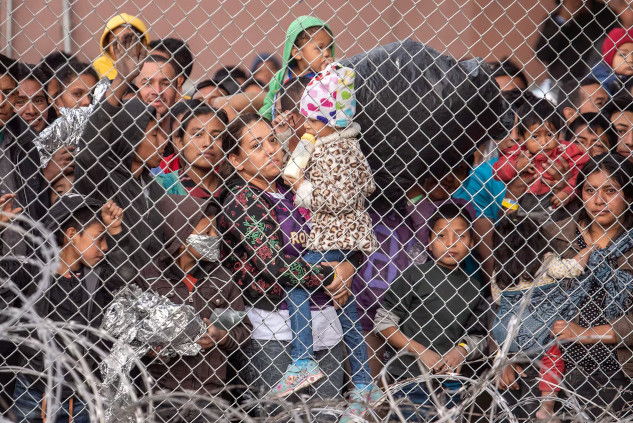
In This Article:
- What is Trump's mass deportation proposal, and how will it be enforced?
- How would deporting 11 million undocumented immigrants affect the U.S. economy?
- What are the psychological and emotional effects on U.S. citizens and immigrant families?
- What is Project 2025’s role in reshaping U.S. immigration policy?
- What will be the long-term social consequences of such a mass deportation policy?
The Reality Behind Trump's Mass Deportation Plan
by Robert Jennings, InnerSelf.com
The issue of immigration is deeply woven into the fabric of American history. Yet, it remains one of modern politics's most contentious and polarizing topics. Former President Donald Trump has reignited the debate with a bold and controversial proposal: the mass deportation of 11 million undocumented immigrants currently living in the United States. While some see this as a necessary measure to protect jobs, national security, and the rule of law, the broader consequences of such an action would ripple across every layer of American society.
This is not just about removing individuals who lack legal status. This is about tearing families apart, destabilizing communities, and throwing entire sectors of the economy into chaos. Even more troubling, the psychological and emotional scars would extend far beyond the immigrant community, affecting minority and white families alike. The implementation of such a plan, especially under the framework of Project 2025—a conservative blueprint designed to reshape U.S. government policy—would lead to nothing less than a humanitarian and economic crisis.
Trump's Deportation Proposal
The plan is simple in its objective: round up and deport 11 million undocumented immigrants. To Trump's supporters, this sounds like a way to restore "law and order" and reclaim jobs for American citizens. However, the logistics and consequences of such a policy are anything but simple.
This plan would require an unprecedented expansion of federal immigration enforcement agencies, most notably Immigration and Customs Enforcement (ICE). Mass raids, workplace enforcement, and community roundups would become routine. Detention centers—already notorious for overcrowding and substandard conditions—would need to expand exponentially to house millions of people awaiting deportation. This alone would present a massive human rights challenge.
For Trump and perhaps the architects of Project 2025, this proposal is about more than just enforcing immigration laws. It is about sending a clear message: if you are undocumented, there is no place for you in the United States. Yet, the human toll of this message goes far beyond the immediate immigrant community, reverberating across families, industries, and communities nationwide.
Economic Impact: A Hollowing Out of Key Industries
Undocumented immigrants are integral to the U.S. economy, particularly in agriculture, construction, and hospitality industries. Deporting 11 million people, many of whom fill these essential jobs, would create a labor shortage so severe that it could cripple critical sectors.
Take agriculture, for example. Undocumented workers make up a large portion of the labor force that picks fruits and vegetables across the U.S. These jobs are physically demanding and often pay low wages, making them unattractive to many U.S. citizens. A mass deportation would leave fields unattended, crops unharvested, and food prices skyrocketing due to shortages. Farmers would be forced to either mechanize—an expensive and not always viable option—or significantly raise wages, further driving up the cost of food. The result? Grocery prices could rise dramatically, hitting low- and middle-income American families the hardest.
In the construction industry, which also relies heavily on undocumented labor, mass deportations would not only delay housing projects and infrastructure development but also lead to a significant rise in the cost of building homes, offices, and public infrastructure. This would result in a slowdown in the housing market and a contraction in the economy. Businesses dependent on affordable immigrant labor would face steep labor costs, reduced productivity, and, in many cases, closure.
The hospitality sector, which employs millions of immigrant workers in restaurants, hotels, and entertainment venues, would suffer similarly. Undocumented workers are often the backbone of these service-oriented industries. With their removal, businesses would struggle to find workers, resulting in higher prices for consumers and a likely reduction in the availability of services.
The Impact on Families: Separation and Devastation
The most immediate and heartbreaking impact of a mass deportation effort would be the separation of families. Many of the 11 million undocumented immigrants targeted by this plan have lived in the U.S. for years—some for decades. They have built lives, formed families, and integrated into American society. Many have U.S.-born children who are legal citizens. Deporting undocumented parents while their children remain in the U.S. would tear families apart, leaving emotional scars that could last a lifetime.
Consider the psychological trauma a child would endure returning home from school to find their parent detained by ICE. The fear, uncertainty, and trauma would be overwhelming. Now, multiply this scenario by the millions of families that would be affected. Children could end up in foster care, separated not just from their parents but from their siblings and extended families. The strain on the foster care system would be immense, and the emotional fallout would be immeasurable.
Even for families that remain intact, the constant fear of deportation would create a climate of anxiety and distress. Parents would live with the fear that they could be separated from their children at any moment. Children would suffer from the stress of this uncertainty, likely impacting their academic performance, mental health, and social development.
The Psychological Toll on U.S. Citizens
The psychological impact of mass deportations would not be confined to immigrant communities. U.S. citizens—both minorities and whites—would feel the effects deeply. Minority communities, particularly those with large Latinx populations, would live under the constant threat of racial profiling. Even U.S.-born citizens who "look foreign" could be stopped, questioned, and harassed simply because of their appearance. This would erode trust between minority communities and law enforcement, making it more difficult for police and public officials to maintain order and cooperation.
Meanwhile, the polarization created by such a drastic policy would further divide the country. White citizens, particularly those who oppose the policy, could experience feelings of guilt, helplessness, and despair. Watching neighbors, co-workers, and friends being deported would be emotionally devastating. Communities that once celebrated diversity and inclusion would become battlefields of fear and distrust as people wonder who will be next.
For some white citizens, there may be a sense of moral conflict—an internal struggle between the desire for law and order and the human cost of enforcing such laws so harshly. This internal division could lead to increased stress, anxiety, and even mental health challenges as citizens grapple with the ethics of supporting or opposing such an extreme measure.
Social and Community Disintegration
Beyond the immediate economic and psychological impacts, the social fabric of the U.S. would be severely weakened. Deporting millions of undocumented immigrants would lead to the disintegration of immigrant communities, many of which have been vibrant and essential parts of American society. Small businesses owned by immigrants would close, local economies would shrink, and neighborhoods would lose their diversity and vitality. The disappearance of these communities would leave a cultural void that would take generations to heal.
Furthermore, mass deportations would create a climate of fear and suspicion. Neighbors might turn on neighbors, families might be divided along ideological lines, and communities that once thrived on diversity and cooperation would become isolated and distrustful. This erosion of social cohesion would affect all Americans, regardless of their stance on immigration. Trust in public institutions, already low, would plummet even further as people begin to question the morality and effectiveness of such a policy.
Project 2025 Aggressive Immigration Enforcement
To understand the full scope of Trump's deportation plan, we must also consider the role of **Project 2025**, a conservative initiative designed to reshape U.S. government policy, including immigration. Project 2025 outlines a future where federal immigration enforcement is expanded and empowered to an unprecedented degree. Under this framework, ICE would receive increased funding, resources, and workforce for mass deportations. Sanctuary cities—jurisdictions that limit cooperation with federal immigration enforcement—would be targeted and pressured into compliance through financial penalties and legal action.
Project 2025 also envisions the elimination of programs like Deferred Action for Childhood Arrivals (DACA), which protects undocumented individuals brought to the U.S. as children. This would put hundreds of thousands of young people at risk of deportation despite having lived most of their lives in the U.S. The overall goal of Project 2025 is to create an immigration system where undocumented individuals have no path to legal status, no protections, and no place in American society. The consequences of such a system would be catastrophic, not just for immigrants but for the entire country.
The Long-Term Consequences: A Weaker, Divided America
The mass deportation of 11 million people would leave a permanent mark on the United States. Economically, it would weaken industries that rely on immigrant labor, driving up prices and reducing productivity. Socially, it would tear apart communities and families, creating a generation of children traumatized by separation. Psychologically, it would deepen the divide between minority communities and law enforcement, leading to increased distrust and social unrest. Politically, it would polarize the country even further as citizens grapple with the ethics and morality of such an extreme measure.
The most significant consequence of all would be the loss of America's soul. The United States has long prided itself on being a nation of immigrants, where people from all corners come to seek freedom, opportunity, and a better life. Deporting 11 million people would send a clear message: that ideal no longer exists. In its place would be a country defined by fear, division, and exclusion.
Mass deportation is not just a policy—it’s a devastating act of social and economic destruction. Trump's proposal, amplified by the framework of Project 2025, would not only harm immigrants but also unravel the fabric of American society. The families torn apart, the children left behind, the communities gutted—these are the human costs we must weigh against the political rhetoric of "law and order." As the debate continues, we must ask ourselves: What kind of country do we want to be? A country that lifts people up or one that tears them down? The future of millions and the nation's soul hangs in the balance.
Article Recap:
Trump’s plan to deport 11 million undocumented immigrants would devastate families and communities, destabilize key industries, and strain social services. Combined with Project 2025, this proposal would fundamentally reshape the U.S. immigration system, promoting aggressive enforcement and the elimination of protections like DACA. The long-term social and economic consequences would weaken the U.S., driving up prices, increasing labor shortages, and fracturing immigrant and non-immigrant communities' social fabric.
About the Author
 Robert Jennings is co-publisher of InnerSelf.com with his wife Marie T Russell. He attended the University of Florida, Southern Technical Institute, and the University of Central Florida with studies in real estate, urban development, finance, architectural engineering, and elementary education. He was a member of the US Marine Corps and The US Army having commanded a field artillery battery in Germany. He worked in real estate finance, construction and development for 25 years before starting InnerSelf.com in 1996.
Robert Jennings is co-publisher of InnerSelf.com with his wife Marie T Russell. He attended the University of Florida, Southern Technical Institute, and the University of Central Florida with studies in real estate, urban development, finance, architectural engineering, and elementary education. He was a member of the US Marine Corps and The US Army having commanded a field artillery battery in Germany. He worked in real estate finance, construction and development for 25 years before starting InnerSelf.com in 1996.
InnerSelf is dedicated to sharing information that allows people to make educated and insightful choices in their personal life, for the good of the commons, and for the well-being of the planet. InnerSelf Magazine is in its 30+year of publication in either print (1984-1995) or online as InnerSelf.com. Please support our work.
Creative Commons 4.0
This article is licensed under a Creative Commons Attribution-Share Alike 4.0 License. Attribute the author Robert Jennings, InnerSelf.com. Link back to the article This article originally appeared on InnerSelf.com
Recommended books:
Capital in the Twenty-First Century
by Thomas Piketty. (Translated by Arthur Goldhammer)
 In Capital in the Twenty-First Century, Thomas Piketty analyzes a unique collection of data from twenty countries, ranging as far back as the eighteenth century, to uncover key economic and social patterns. But economic trends are not acts of God. Political action has curbed dangerous inequalities in the past, says Thomas Piketty, and may do so again. A work of extraordinary ambition, originality, and rigor, Capital in the Twenty-First Century reorients our understanding of economic history and confronts us with sobering lessons for today. His findings will transform debate and set the agenda for the next generation of thought about wealth and inequality.
In Capital in the Twenty-First Century, Thomas Piketty analyzes a unique collection of data from twenty countries, ranging as far back as the eighteenth century, to uncover key economic and social patterns. But economic trends are not acts of God. Political action has curbed dangerous inequalities in the past, says Thomas Piketty, and may do so again. A work of extraordinary ambition, originality, and rigor, Capital in the Twenty-First Century reorients our understanding of economic history and confronts us with sobering lessons for today. His findings will transform debate and set the agenda for the next generation of thought about wealth and inequality.
Click here for more info and/or to order this book on Amazon.
Nature's Fortune: How Business and Society Thrive by Investing in Nature
by Mark R. Tercek and Jonathan S. Adams.
 What is nature worth? The answer to this question—which traditionally has been framed in environmental terms—is revolutionizing the way we do business. In Nature’s Fortune, Mark Tercek, CEO of The Nature Conservancy and former investment banker, and science writer Jonathan Adams argue that nature is not only the foundation of human well-being, but also the smartest commercial investment any business or government can make. The forests, floodplains, and oyster reefs often seen simply as raw materials or as obstacles to be cleared in the name of progress are, in fact as important to our future prosperity as technology or law or business innovation. Nature’s Fortune offers an essential guide to the world’s economic—and environmental—well-being.
What is nature worth? The answer to this question—which traditionally has been framed in environmental terms—is revolutionizing the way we do business. In Nature’s Fortune, Mark Tercek, CEO of The Nature Conservancy and former investment banker, and science writer Jonathan Adams argue that nature is not only the foundation of human well-being, but also the smartest commercial investment any business or government can make. The forests, floodplains, and oyster reefs often seen simply as raw materials or as obstacles to be cleared in the name of progress are, in fact as important to our future prosperity as technology or law or business innovation. Nature’s Fortune offers an essential guide to the world’s economic—and environmental—well-being.
Click here for more info and/or to order this book on Amazon.
Beyond Outrage: What has gone wrong with our economy and our democracy, and how to fix it -- by Robert B. Reich
 In this timely book, Robert B. Reich argues that nothing good happens in Washington unless citizens are energized and organized to make sure Washington acts in the public good. The first step is to see the big picture. Beyond Outrage connects the dots, showing why the increasing share of income and wealth going to the top has hobbled jobs and growth for everyone else, undermining our democracy; caused Americans to become increasingly cynical about public life; and turned many Americans against one another. He also explains why the proposals of the “regressive right” are dead wrong and provides a clear roadmap of what must be done instead. Here’s a plan for action for everyone who cares about the future of America.
In this timely book, Robert B. Reich argues that nothing good happens in Washington unless citizens are energized and organized to make sure Washington acts in the public good. The first step is to see the big picture. Beyond Outrage connects the dots, showing why the increasing share of income and wealth going to the top has hobbled jobs and growth for everyone else, undermining our democracy; caused Americans to become increasingly cynical about public life; and turned many Americans against one another. He also explains why the proposals of the “regressive right” are dead wrong and provides a clear roadmap of what must be done instead. Here’s a plan for action for everyone who cares about the future of America.
Click here for more info or to order this book on Amazon.
This Changes Everything: Occupy Wall Street and the 99% Movement
by Sarah van Gelder and staff of YES! Magazine.
 This Changes Everything shows how the Occupy movement is shifting the way people view themselves and the world, the kind of society they believe is possible, and their own involvement in creating a society that works for the 99% rather than just the 1%. Attempts to pigeonhole this decentralized, fast-evolving movement have led to confusion and misperception. In this volume, the editors of YES! Magazine bring together voices from inside and outside the protests to convey the issues, possibilities, and personalities associated with the Occupy Wall Street movement. This book features contributions from Naomi Klein, David Korten, Rebecca Solnit, Ralph Nader, and others, as well as Occupy activists who were there from the beginning.
This Changes Everything shows how the Occupy movement is shifting the way people view themselves and the world, the kind of society they believe is possible, and their own involvement in creating a society that works for the 99% rather than just the 1%. Attempts to pigeonhole this decentralized, fast-evolving movement have led to confusion and misperception. In this volume, the editors of YES! Magazine bring together voices from inside and outside the protests to convey the issues, possibilities, and personalities associated with the Occupy Wall Street movement. This book features contributions from Naomi Klein, David Korten, Rebecca Solnit, Ralph Nader, and others, as well as Occupy activists who were there from the beginning.
Click here for more info and/or to order this book on Amazon.










